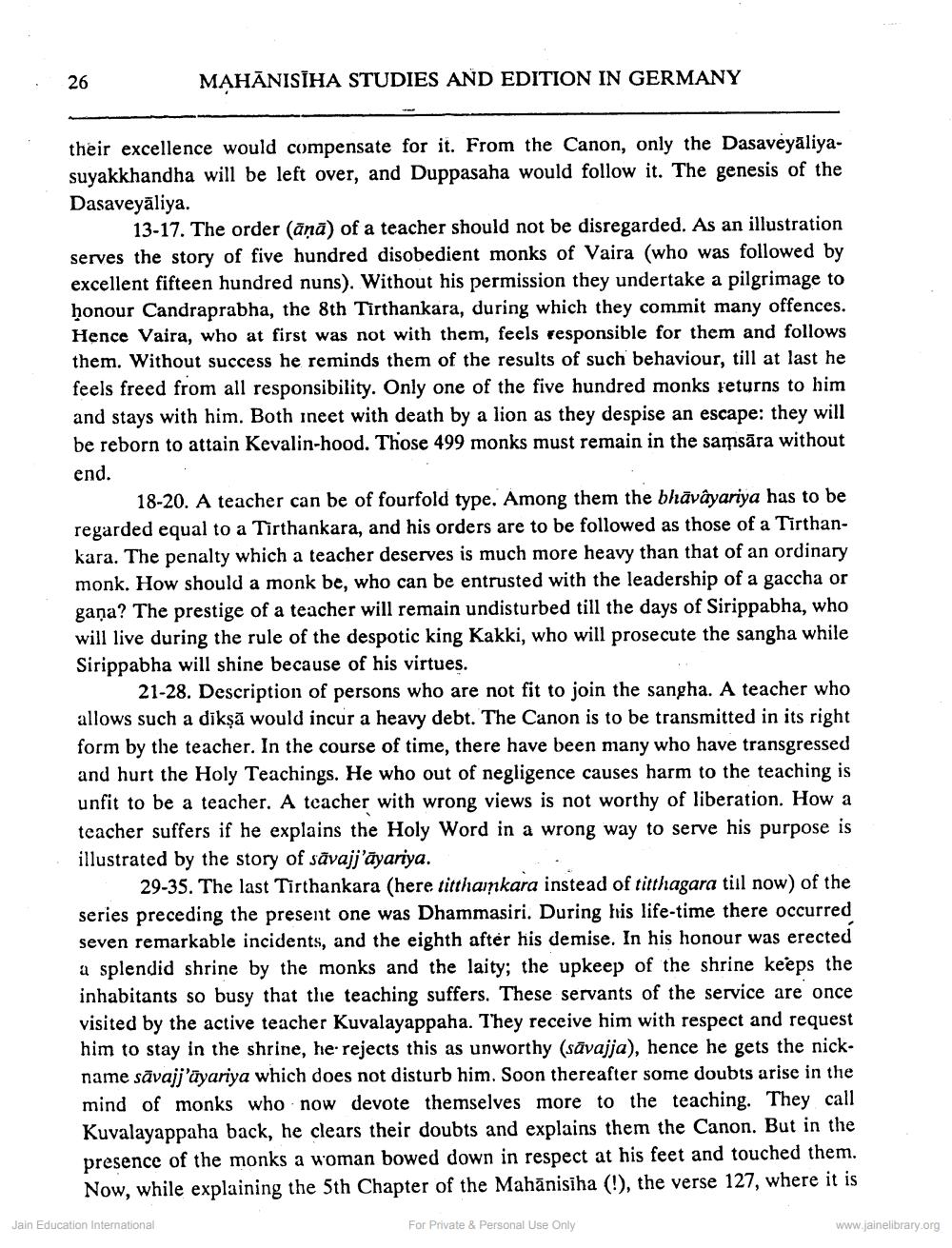________________
26
MAHĀNISĪHA STUDIES AND EDITION IN GERMANY
their excellence would compensate for it. From the Canon, only the Dasaveyaliyasuyakkhandha will be left over, and Duppasaha would follow it. The genesis of the Dasaveyāliya.
13-17. The order (āņā) of a teacher should not be disregarded. As an illustration serves the story of five hundred disobedient monks of Vaira (who was followed by excellent fifteen hundred nuns). Without his permission they undertake a pilgrimage to honour Candraprabha, the 8th Tirthankara, during which they commit many offences. Hence Vaira, who at first was not with them, feels responsible for them and follows them. Without success he reminds them of the results of such behaviour, till at last he feels freed from all responsibility. Only one of the five hundred monks returns to him and stays with him. Both ineet with death by a lion as they despise an escape: they will be reborn to attain Kevalin-hood. Those 499 monks must remain in the samsāra without end.
18-20. A teacher can be of fourfold type. Among them the bhāvâyariya has to be regarded equal to a Tirthankara, and his orders are to be followed as those of a Tirthankara. The penalty which a teacher deserves is much more heavy than that of an ordinary monk. How should a monk be, who can be entrusted with the leadership of a gaccha or gana? The prestige of a teacher will remain undisturbed till the days of Sirippabha, who will live during the rule of the despotic king Kakki, who will prosecute the sangha while Sirippabha will shine because of his virtues.
21-28. Description of persons who are not fit to join the sangha. A teacher who allows such a dikṣā would incur a heavy debt. The Canon is to be transmitted in its right form by the teacher. In the course of time, there have been many who have transgressed and hurt the Holy Teachings. He who out of negligence causes harm to the teaching is unfit to be a teacher. A teacher with wrong views is not worthy of liberation. How a teacher suffers if he explains the Holy Word in a wrong way to serve his purpose is illustrated by the story of sävajj'āyariya.
29-35. The last Tirthankara (here titthainkara instead of titthagara till now) of the series preceding the present one was Dhammasiri. During his life-time there occurred seven remarkable incidents, and the eighth after his demise. In his honour was erected a splendid shrine by the monks and the laity; the upkeep of the shrine keeps the inhabitants so busy that the teaching suffers. These servants of the service are once visited by the active teacher Kuvalayappaha. They receive him with respect and request him to stay in the shrine, he rejects this as unworthy (sāvajja), hence he gets the nickname sāvajj'āyariya which does not disturb him. Soon thereafter some doubts arise in the mind of monks who now devote themselves more to the teaching. They call Kuvalayappaha back, he clears their doubts and explains them the Canon. But in the presence of the monks a woman bowed down in respect at his feet and touched them. Now, while explaining the 5th Chapter of the Mahānisiha (!), the verse 127, where it is
Jain Education International
For Private & Personal Use Only
www.jainelibrary.org




